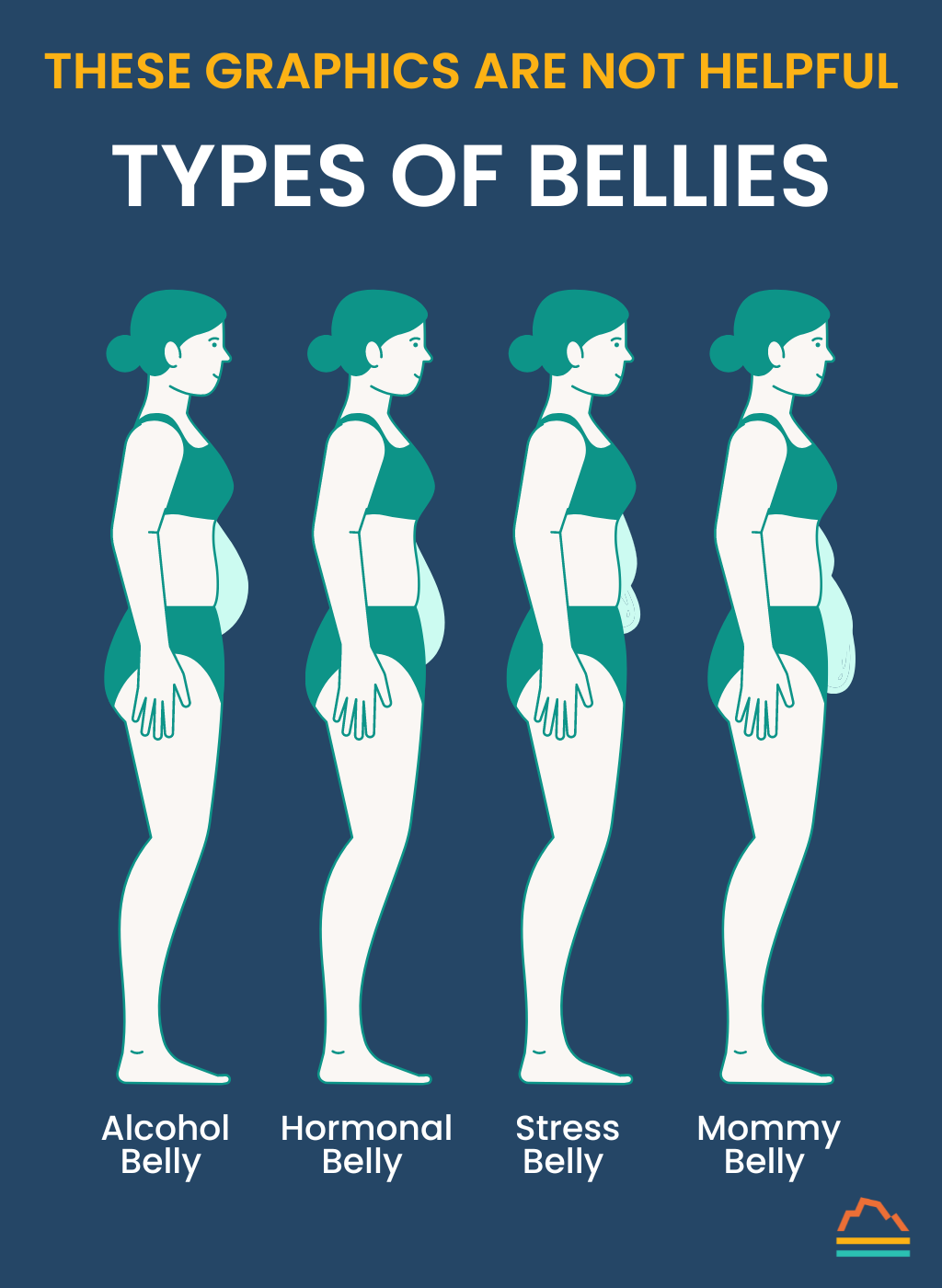You may not believe this, but not everything you read on the internet is true — especially when it comes to medical facts.
Shocking, I know.
You may have heard of something called “stress belly” and wondered what it looks like. Stress belly is a real phenomenon, but it’s very different from the images and blog posts you’ll find if you Google “what does a stress belly look like.”

Those images are total BS.
There’s no way to immediately identify the cause of abdominal fat deposition simply by looking at the belly. (Plus, anyone who carries so much fat on their abdomen won’t look like a supermodel everywhere else.)
That being established, what is a stress belly, and what does a stress belly look like?
What Does a Stress Belly Look Like?
Stress belly is the result of a direct physiological link between the emotional stress you experience and increased fat deposition in your abdominal cavity.
Not everyone with abdominal obesity has a stress belly. Likewise, not everyone who experiences excess stress develops a stress belly or abdominal obesity. However, there’s enough overlap to ensure a genuine phenomenon, although it’s not explanatory for all instances.
Causes and Symptoms of Stress Belly
There are many instances of powerful, intricate relationships between our emotional state and our physical state.
A lot of literature links socioeconomic status to health outcomes. For example, if you’re struggling financially, you may not be able to consistently provide food or housing for yourself or your family. The amount of stress engendered by a lower socioeconomic status is considerable.
When we experience chronic stress, we see elevated levels of adrenaline and cortisol, a glucocorticoid which can be measured in saliva, blood, and even hair. These elevated levels correlate with worse health outcomes.
Too much cortisol can set a whole host of other hormonal changes into motion, including putting more adipose (fat) cells within the abdomen. These visceral fat cells are hormonally active, pro-inflammatory, create insulin resistance, and worsen hypertension, which are all risk factors for coronary artery disease.
They’re part of a worsening feed-forward loop that also influences hormones that regulate appetite, like leptin and ghrelin. This causes people under stress to crave comfort foods (foods high in sugar and fat), which compound obesity and continue the feed-forward loop.
Together, all these factors form an unfortunately strong and documented pathway — starting with socioeconomic status and emotional state and leading to increased fat content, heightened cardiovascular risk, and many other downstream health complications.
Risk Factors for Stress Belly
The risk factors for stress belly begin with its namesake — stress. Despite the documented link between socioeconomic status and stress, stress can affect anyone in any circumstance.
Stress isn’t always caused by emotion, either. For example, chronic pain can cause stress. It’s like kicking someone when they’re down.
Another cause of stress — and therefore excessive cortisol, or hypercortisolism — can be a lack of sleep. If you consistently fail to get the proper quantity or quality of sleep, your body generates more adrenaline and cortisol. This especially affects night shift workers, whose circadian rhythms are all out of whack.
The same thing happens when you consume alcohol. Most people equate drinking with relaxation. However, as your body metabolizes alcohol, it releases adrenaline and cortisol, which stresses your body and induces hypercortisolism.
Stress Belly Treatment
So you’ve gotten past “what does a stress belly look like?” and moved on to “how do I get rid of my stress belly?” I hear you.
The best way to combat stress belly is to identify and address its contributing factors. Then, double down as much as you can on removing or managing the factors that cause undue stress and lead to hypercortisolism.
Emotional Stress
When emotional stress weighs heavily, meditation, cognitive behavioral therapy, exercise, and other techniques and tools can relieve some of the burden. Don’t wait until you feel overwhelmed before you ask for help.
Chronic Pain
If you’re experiencing chronic pain, you may not be able to remove the pain or the source of the pain completely, but there may be ways to improve your quality of life. For instance, through meditation, therapy, or other modalities, you may be able to emotionally reframe your pain so it’s less stressful to your body.
Alcohol
Alcohol consumption can be simpler to limit (or omit), but not always. Alcohol is not part of the solution for stress — it’s part of the problem.
If you need help limiting or abstaining from alcohol, contact your doctor or a support group near you.
Sleep
Sleep is crucial to wellness. However, improving sleep can be incredibly complicated.
If you’re having trouble sleeping, please talk to your doctor or contact us here at Banner Peak Health. We’ll be glad to speak with you.
Today’s Takeaways
- All the charts that pop up when you Google “What does a stress belly look like?” are BS.
- Stress belly is real. No, you can’t tell if you (or anyone else) have it just by looking.
- Stress belly increases the risk for a wide array of illnesses, including diabetes, high blood pressure, and coronary artery disease.
- Treatment for stress belly involves managing and omitting the causes of stress. These can include emotional stress, chronic pain, alcohol, and poor sleep.

Barry Rotman, MD
For over 30 years in medicine, Dr. Rotman has dedicated himself to excellence. With patients’ health as his top priority, he opened his own concierge medical practice in 2007 to practice medicine in a way that lets him truly serve their best interests.




